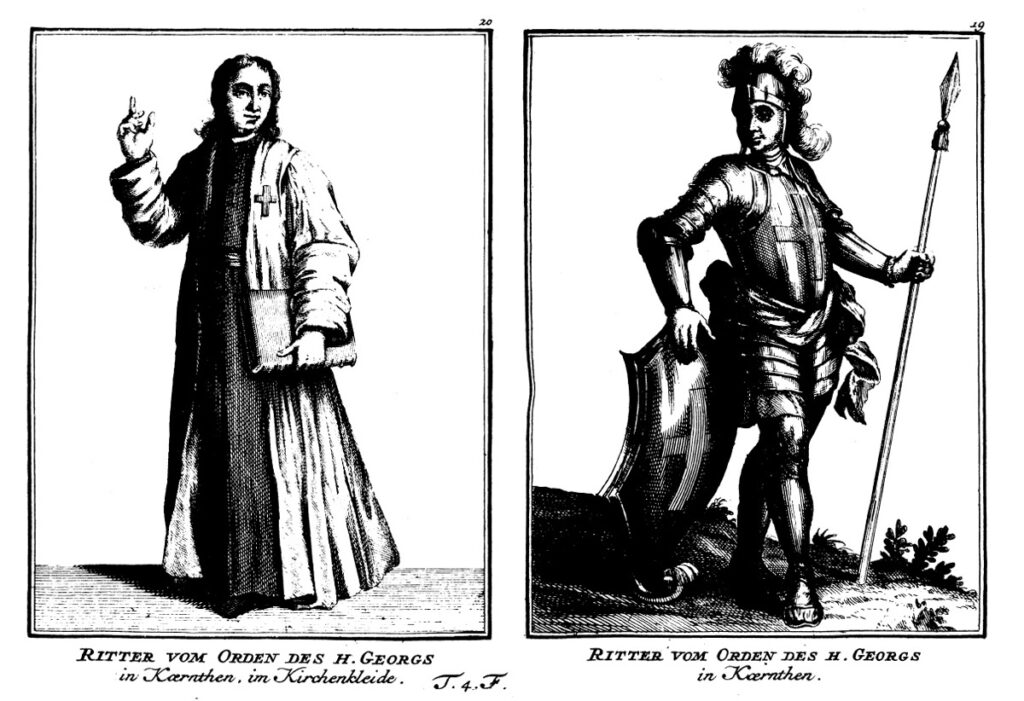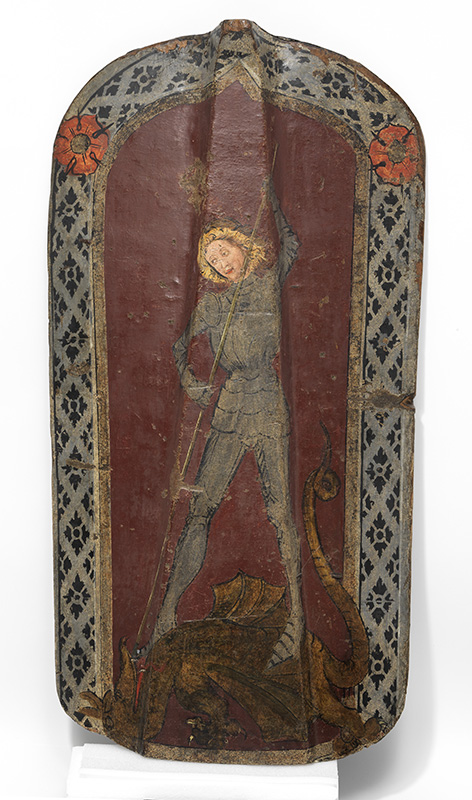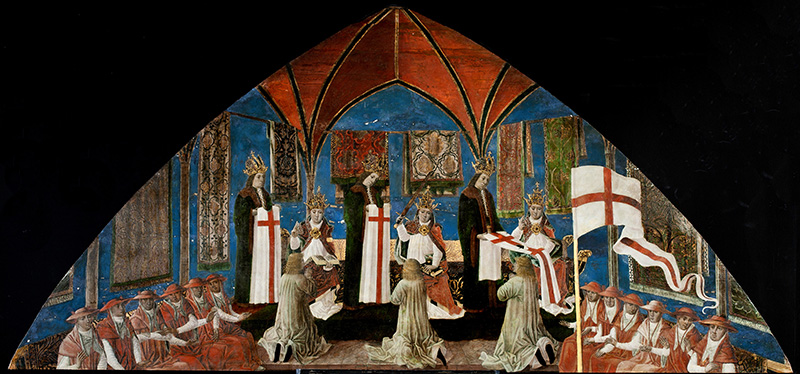Our roots
The Order of St. George is a dynastic house order and combines chivalric tradition with the idea of a united Europe in the sense of the political ideas of Otto von Habsburg. The roots of the Order go back a long way, not meaning uninterrupted continuity, but continuation of an ideal of Christian chivalry. The history of the Order of St George in Central Europe began in the Kingdom of Hungary in the 14th century, experienced its heyday as the Habsburg House Order at the beginning of the modern era, was reinterpreted after the end of the First World War and continued as a dynastic House Order of the 21st century on behalf of HIRH Archduke Otto and his son HIRH Karl von Habsburg. In 2008, the first chapter of the modern Order was elected in Munich.

Engravings from P. Hippolyt Helyot’s „Detailed history of all religious and secular monastic and knightly orders.“, Volume 4, Arkstee und Merkus, Leipizig 1756, Private collection Vienna
Saint George
George the Martyr is one of the most popular saints in Christianity; his day of remembrance is 23 April. George is the patron saint of England, Georgia, Ethiopia, Greece, Serbia, Aragon and Catalonia and – together with St. Joseph – the patron saint of Tyrol. He is one of the 14 emergency helpers and is regarded as a protector against the danger of war, plague and fever. He is the patron saint of soldiers, farmers, horsemen, miners, blacksmiths and prisoners.
Little is known about the historical George. He died as a martyr in Nicomedia, today‘s Izmir – according to other legends in Lydda, today‘s Lod in Israel – at the beginning of the persecution of Christians under Diocletian. His veneration began as early as the 4th century, so there is probably no reason to doubt his existence. According to legend, he was born to a wealthy family in Cappadocia, his mother Polychronia was a Christian and had him baptised too. George was a soldier in the Roman army and was decorated for his courage.
The figure of the saint is associated with numerous legends, the most famous being his fight with the dragon. In the „Legenda Aurea“ from the 13th century, it is reported that the Knight George came to the city of Silena in Libya. There dwelt a dragon who polluted the city with his poisonous breath. The inhabitants had to sacrifice lambs to it every day, and when there were no more, the sons and daughters were thrown to the beast. One day, the king‘s daughter met her fate, but when she was thrown to the dragon, George appeared. He made the sign of the cross with his lance and pierced the dragon but did not kill it. He told the king‘s daughter to bind the dragon with her belt and lead it into the city. The inhabitants panicked, but George promised to kill the dragon if everyone got baptised. The king and 20,000 people converted to Christ and George slew the beast.

Photo: Birgit and Peter Kainz, Wien Museum
Patron saint of Knights
The veneration of the saint spread throughout Christendom at an early stage. In Byzantium, he was venerated as a soldier and noble saint from 525 onwards, and from the year 1000 onwards the dragon legend became established in the Eastern churches, and in the West at the time of the Crusades.
In 1099, George, riding on a white horse, is said to have helped the Crusaders to victory over the Saracens at Antioch. Richard the Lionheart made him his personal patron saint, and at the Synod of Oxford in 1222 the saint‘s name day became a national holiday. George was regarded as the patron saint of the Knights of the Holy Roman Empire, and the Teutonic Order, founded in 1191 before Acre, also promoted his veneration. Around 1250, commissioned by the Bavarian Duke Otto II the Illustrious of the House of Wittelsbach, Reinbot von Durne wrote the George Novel, a verse poem about the saint, which was one of the most widespread books of the Middle Ages and praised St. George as a model of the Christian Knight.
Orders and Societies of Chivalry in the Kingdom of Hungary
The Order of St. George of the House of Anjou
On 23 April 1326, St George‘s Day, the statutes of a society founded by the Hungarian King Charles I (1301-1342) of the House of Anjou were proclaimed before the cathedral chapter of Gran, Esztergom in Hungary, „to protect both his body and his life and thus the country.“ The founding statute is now in the Hungarian National Archives, together with the seal depicting St. George as the dragon slayer.
It was the first secular order of knighthood and became the model for dynastic orders. The Hungarian Order of St George still flourished under King Louis the Great (1342-1382), but it did not survive the throne disputes that flared up in Hungary after Louis‘ death.
The Order of the Dragon
On December 12, 1408, Sigismund (1382-1437) of the House of Luxemburg founded the Order of the Dragon as King of Hungary. The statute sets as its goal the fight against „the followers of the primal dragon, that is, both the pagan troops and the Schismatics“ and against all nations that oppose the Christian faith. In 1409, the Austrian dukes Ernst, Wilhelm and Albrecht from the House of Habsburg and another 24 Austrian nobles were admitted to the Order. The Order of the Dragon was interdenominational; Orthodox Christians were also admitted. It was also the only society of Knights to admit women, including Barbara of Cilli, the wife of Emperor Sigismund.
In 1431, the king granted Vlad II, voivode of Wallachia, membership of the Order. He was given his epithet „Dracul“ (dragon) after he joined the society – the name later given to his son Vlad III Tepes in literature and pop culture. Dracula can therefore ultimately be traced back to the Order of the Dragon.
The Order of the Dragon outlived its founder Sigismund. His successor, King Albrecht of the House of Habsburg, bestowed the Order on potential allies in the empire. After Albrecht‘s early death (1397-1439), his son Ladislaus Postumus (1440-1457) became not only King of Hungary but also Grand Master of the Order of the Dragon. His cousin Frederick of Austria (1415-1493) – known as Emperor Frederick III – exercised the regency for Ladislaus and also awarded the Order of the Dragon at least twice. King Matthias Corvinus (1443-1490) is said to have awarded the Order of the Dragon for the last time.
The Order of St. George as a House Order of the Habsburgs
In 1337, Duke Otto the Merry (1301-1339) founded a society of Knights, the Societas Templois. The meeting place was St. George‘s Chapel in the Au- gustinian Church in Vienna, and liturgical meetings of the order are mentioned there until 1378. Otto the Merry, founder of the first order of Knights associated with St. George, died in the monastery he founded in Neuberg an der Mürz and was buried there.
In 1462 Emperor Frederick III was besieged by rebellious citizens in the Vienna Hofburg. In the event of a successful outcome, he vowed to found an order of Knights dedicated to St. George to ward off the Turks. In 1468 the emperor travelled to Rome, where Pope Paul II confirmed the foundation of the order. On January 1, 1469 the Bull of Foundation of the Order was issued, and Johann Siebenhirter, a close confidant of the Emperor, became the first Grand Master. His Grand Master‘s sword is still preserved in the Carinthian State Museum.

The upper part of the Siebenhirter table shows the installation of the first Grand Master of the Order of St. George, Johann Siebenhirter, on January 1st, 1469 in the Lateran Basilica in Rome by Pope Paul II and the founder of the order, Emperor Friedrich III. In a synchronized representation, one sees Emperor Friedrich standing, the Pope seated and Johann Siebenbürger kneeling in front of him taking the oath of allegiance, accolade and investiture with the medal.
The large-format panel was originally located in the Siebenhirter Chapel in the former Millstatt Benedictine Abbey and is now one of the treasures of Gothic painting in the Carinthian State Museum. In 2020 the board was extensively restored.
The monastery of Millstatt became the seat of the Order and was expanded to become the residence of the Grand Master. The church contains the epitaphs of the Grand Master Johann Sieben-Hirter (†1508) and his successor, Johann Geumann (†1533).
Emperor Maximilian (1459-1519) was a great supporter of the Order of St George founded by his father. In 1493 he founded the Brotherhood of St. George in Innsbruck, a secular fraternity that was to be affiliated with the Order. When Maximilian died, he ordered that he be buried in the regalia of a Knight of St. George. His effigy, today in the Joanneum in Graz, shows his body wrapped in black satin with the cross of St. George on it.
Under Maximilian‘s successor, Emperor Charles V, the Golden Fleece became the pride of the Habsburgs, and at the same time interest in the Order of St. George waned. After the death of the third Grand Master Wolfgang Prandtner in 1541, no successor was appointed. In 1573, the proceeds of the Order‘s properties were used for the newly founded Jesuit College in Graz, and in 1598 the entire property of the Order was handed over to it.
What remained, however, was the veneration of St. George. Emperor Maximilian had declared him the patron saint of the House of Habsburg.
The Order of the Four Roman Emperors, also known as the Old Order of St. George
In 1768, Count Philipp Ferdinand of Limburg-Styrum founded the „Order of the Ancient Nobility of the Four Roman Emperors“, referring to the foundation of the order in 1308 by Henry VII, the first emperor from the House of Luxembourg. Limburg-Styrum was one of the smallest territories of the Holy Roman Empire, but already attained imperial immediacy at the beginning of the 13th century.
In 1794, Imperial Count Philipp Ferdinand died, his successor Ernst Maria lost the dominion in the same year due to the occupation by the troops of revolutionary France, and in 1806 the Imperial County was finally mediated. The „Order of the Ancient Nobility of the Four Roman Emperors“ had probably already lost its significance as the house order of the Imperial Counts of Limburg-Styrum with the death of Philipp Ferdinand.
In 1838, Joseph Vicomte de Kerckhove-Varent reorganised the Order and emphasised the continuity with the Luxembourg foundation of the Order in the Middle Ages. However, in Ferdinand von Biedenfeld‘s „Geschichte und Verfassung aller geistlichen und weltlichen, erlöschenen und blühenden Ritterorden“ (History and Constitution of all Spiritual and Secular, Extinct and Flourishing Orders of Chivalry), written in 1841, this continuity was called into question and rejected for lack of source material. The insignia of the Order was a white enamelled eight-pointed cross with the letters H. C. W. S., the initials of the four members of the House of Luxembourg on the imperial throne. In the centre is a medallion with a guardian angel on an azure background, the guardian angel was the patron saint of the Order. The blue central part was surrounded by a wide red border. Such Order crosses from the 19th century have survived until today.
In 1923, officers of the German Empire and the Austro-Hungarian Empire, the Central Powers allied in the First World War, founded an association. Its orientation was monarchist and placed itself in the tradition of the Holy Roman Empire. In 1926, in a reorganisation convention in Hanover, the tradition of the former Limburg House Order was also integrated, especially the reference to the four Luxembourg emperors and their initials in the insignia. In 1927, the statutes were adapted to deepen the Order and it was given the name „Old Order of Knights of Saint George called Order of the Four Roman Emperors“, with the Balleys Wendland, Lower Saxony, Rhineland-Westphalia, Southern Germany and Austria-Hungary. An expression of this renewal of the Order in spirit was the adoption of Saint George in the Order‘s emblem. The position of Grand Master was left vacant and the leadership of the Order was held by a Governor. In 1935, the Order‘s headquarters were moved to Salzburg in the Ballei of Austria-Hungary, from where it took a stand against National Socialism. In 1937 Prince Johannes von und zu Liechtenstein was appointed Governor of the Order. After the Anschluss in 1938, the Order‘s assets were also confiscated in Austria and the Order was banned.
After the war, Prince Johannes rebuilt the structure of the Order as an association with the name „St. George‘s Club“ based in Vienna. In 1960 the name was changed to „Der Alte Orden vom St. Georg“ (The Old Order of St George). At the end of the 1960s, Otto von Habsburg took over the honorary patronage. The founders of the „Order of St. George – A European Order of the House of Habsburg-Lothringen“, which was renewed in 2008, came from the circle of the „Old Order of St. George“.
A European Order of the House of Habsburg-Lothringen
On 18 January 2008, on behalf of HIRH Archduke Otto and his son HIRH Archduke Karl, the foundation of the European Order of St. George was celebrated in Munich and a first chapter of the modern Order was elected.
On 24 April 2010, the Order was given a new constitution. The legal sponsor became the „Society of the Knights of the Order of St. George“, formed according to Austrian association law, with the aim of fighting for a Christian, Western Europe, which is in danger of increasingly losing its Christian and historical roots, and to strengthen the historical ties between the countries of Central Europe under the auspices of the House of Habsburg-Lothringen.
On 30 April 2011, in the Minster at Neuberg an der Mürz – at the resting place of Duke Otto the Merry, the founder of the first Habsburg Order of St. George – the „Order of St. George – A European Order of the House of Habsburg-Lothringen“ was solemnly proclaimed by HIRH Archduke Karl as Grand Master.
HIRH Archduke Karl assumed the role of Grand Master, Baron Dr. Norbert van Handel became Procurator of the Order. The latter rendered great service in this important construction phase. On 22 April 2017, at the Order‘s Convention in Kufstein, Grand Master HIRH Archduke Karl appointed Baron Vinzenz von Stimpfl-Abele as Procurator of the Order of St. George, under whose leadership our community is gradually developing into a socially recognised, non-partisan politically valued authority.
